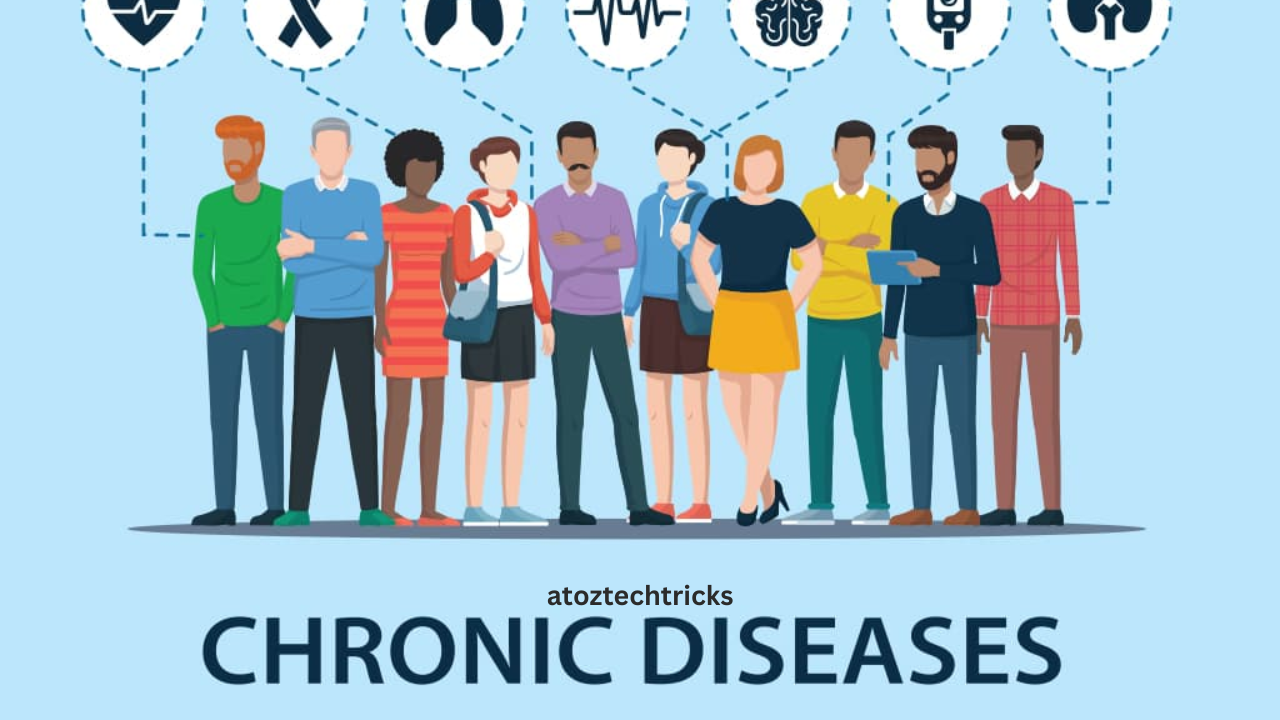Common Types of Chronic Illnesses: An In-Depth Overview
Chronic illnesses are long-term health conditions that persist for months or years and often require ongoing management and treatment. They can significantly impact an individual’s quality of life and overall well-being. Understanding common types of chronic illnesses, their symptoms causes, and management strategies is crucial for both individuals affected by these conditions and those supporting them. This comprehensive guide explores various chronic illnesses, providing insights into their characteristics and approaches to managing them effectively.
1. Diabetes Mellitus
Overview
Diabetes Mellitus is a chronic metabolic disorder characterized by high blood sugar levels due to either insufficient insulin production or the body’s inability to use insulin effectively. There are two primary types of diabetes:
- Type 1 Diabetes: An autoimmune condition where the body’s immune system attacks insulin-producing cells in the pancreas. It typically develops in childhood or adolescence.
- Type 2 Diabetes: A condition where the body becomes resistant to insulin or does not produce enough insulin. It is more common in adults and is often associated with obesity and lifestyle factors.
Symptoms
- Frequent urination
- Excessive thirst and hunger
- Unexplained weight loss
- Fatigue
- Blurred vision
- Slow-healing sores or frequent infections
Causes and Risk Factors
- Genetics: A family history of diabetes increases the risk.
- Obesity: Excess body fat, particularly abdominal fat, is a significant risk factor for Type 2 Diabetes.
- Age: The risk increases with age, especially after 45.
- Physical Inactivity: Lack of exercise contributes to the development of Type 2 Diabetes.
- Diet: High consumption of sugary and processed foods can increase risk.
Management Strategies
- Lifestyle Changes: Adopting a healthy diet, regular exercise, and maintaining a healthy weight are crucial for managing diabetes.
- Medication: Insulin injections or oral medications may be required to control blood sugar levels.
- Monitoring: Regular monitoring of blood glucose levels helps manage diabetes effectively.
- Education and Support: Diabetes education programs and support groups can provide valuable information and emotional support.
2. Hypertension (High Blood Pressure)
Overview
Hypertension, or high blood pressure, is a condition where the force of the blood against the artery walls is consistently too high. This can lead to serious health issues, including heart disease, stroke, and kidney damage.
Symptoms
- Often asymptomatic; hence, it is known as a “silent killer.”
- Headaches
- Dizziness
- Shortness of breath
- Nosebleeds (in severe cases)
Causes and Risk Factors
- Genetics: A family history of hypertension can increase risk.
- Diet: High salt intake, excessive alcohol consumption, and poor diet contribute to high blood pressure.
- Obesity: Excess weight increases the risk of developing hypertension.
- Lack of Physical Activity: A sedentary lifestyle can contribute to high blood pressure.
- Chronic Stress: Long-term stress can impact blood pressure levels.
Management Strategies
- Diet: Adopting a heart-healthy diet low in sodium and rich in fruits, vegetables, and whole grains.
- Exercise: Regular physical activity helps lower blood pressure.
- Medication: Antihypertensive medications may be prescribed to manage blood pressure.
- Lifestyle Modifications: Reducing alcohol intake, quitting smoking, and managing stress are essential for controlling hypertension.
Cultivating a Holistic Mindset for Better Health: A Comprehensive Guide
3. Asthma
Overview
Asthma is a chronic respiratory condition characterized by inflammation and narrowing of the airways, leading to difficulty breathing. It can vary in severity and may be triggered by various environmental factors.
Symptoms
- Shortness of breath
- Wheezing
- Coughing, especially at night or early morning
- Chest tightness
- Increased mucus production
Causes and Risk Factors
- Genetics: A family history of asthma or allergic conditions increases risk.
- Allergens: Exposure to allergens such as pollen, dust mites, and pet dander can trigger asthma symptoms.
- Environmental Factors: Exposure to smoke, pollution, and respiratory infections can contribute to asthma development.
- Exercise: Physical activity, especially in cold or dry air, can trigger asthma symptoms.
Management Strategies
- Medications: Inhaled corticosteroids, bronchodilators, and other medications can help control asthma symptoms and reduce inflammation.
- Avoid Triggers: Identifying and avoiding triggers such as allergens and pollutants.
- Monitoring: Regular use of a peak flow meter to monitor lung function and adjust medication as needed.
- Education: Learning proper inhaler techniques and understanding asthma management strategies.
4. Chronic Obstructive Pulmonary Disease (COPD)

Overview
COPD is a progressive lung disease characterized by obstructed airflow and difficulty breathing. It primarily includes chronic bronchitis and emphysema. COPD is often caused by long-term exposure to irritants such as tobacco smoke.
Symptoms
- Chronic cough with mucus production
- Shortness of breath, especially during physical activities
- Wheezing
- Frequent respiratory infections
- Fatigue
Causes and Risk Factors
- Smoking: The leading cause of COPD; long-term tobacco use significantly increases risk.
- Environmental Exposure: Exposure to pollutants, dust, and chemicals in the workplace can contribute to COPD.
- Genetics: A rare genetic disorder called alpha-1 antitrypsin deficiency can increase susceptibility to COPD.
Management Strategies
- Smoking Cessation: Quitting smoking is the most crucial step in managing COPD.
- Medications: Bronchodilators and inhaled corticosteroids can help manage symptoms and improve lung function.
- Pulmonary Rehabilitation: A program of exercise, education, and support to help individuals manage COPD.
- Oxygen Therapy: For advanced cases, supplemental oxygen may be required.
5. Rheumatoid Arthritis
Overview
Rheumatoid arthritis (RA) is an autoimmune disorder that primarily affects the joints, causing inflammation, pain, and swelling. Over time, RA can lead to joint damage and deformity.
Symptoms
- Joint pain and swelling, especially in the hands and feet
- Morning stiffness lasting more than an hour
- Fatigue
- Fever
- Loss of appetite
Causes and Risk Factors
- Genetics: A family history of RA or other autoimmune diseases increases risk.
- Gender: RA is more common in women than men.
- Age: It can occur at any age but commonly starts between 30 and 60.
- Environmental Factors: Smoking and certain infections may contribute to the development of RA.
Management Strategies
- Medications: Disease-modifying antirheumatic drugs (DMARDs), biologics, and nonsteroidal anti-inflammatory drugs (NSAIDs) are used to manage RA symptoms and slow disease progression.
- Physical Therapy: Exercises and therapy can help maintain joint function and reduce pain.
- Lifestyle Modifications: Regular exercise, stress management, and a balanced diet can improve overall well-being and support joint health.
- Surgery: In severe cases, surgical interventions may be needed to repair or replace damaged joints.
6. Crohn’s Disease
Overview
Crohn’s disease is a type of inflammatory bowel disease (IBD) characterized by chronic inflammation of the gastrointestinal tract. It can affect any part of the digestive tract from the mouth to the anus.
Symptoms
- Abdominal pain and cramping
- Diarrhoea, sometimes with blood
- Weight loss
- Fatigue
- Reduced appetite
Causes and Risk Factors
- Genetics: A family history of Crohn’s disease or other autoimmune conditions increases risk.
- Immune System: An abnormal immune response may contribute to the inflammation seen in Crohn’s disease.
- Environmental Factors: Diet, smoking, and certain infections may play a role in triggering or exacerbating the disease.
Management Strategies
- Medications: Anti-inflammatory drugs, immunosuppressants, and biologics can help control inflammation and manage symptoms.
- Diet and Nutrition: Tailoring diet to individual needs and avoiding trigger foods can help manage symptoms.
- Surgery: In cases where medications are not effective, surgery may be needed to remove damaged sections of the gastrointestinal tract.
- Support and Education: Support groups and education about the disease can help individuals manage their condition more effectively.
7. Multiple Sclerosis (MS)
Overview
Multiple sclerosis (MS) is a chronic autoimmune disease that affects the central nervous system, causing damage to the myelin sheath that protects nerve fibres. This damage disrupts communication between the brain and the rest of the body.
Symptoms
- Numbness or tingling in limbs
- Muscle weakness
- Difficulty with coordination and balance
- Vision problems
- Fatigue
- Cognitive changes
Causes and Risk Factors
- Genetics: A family history of MS or other autoimmune diseases increases risk.
- Gender: MS is more common in women than men.
- Age: It often begins between the ages of 20 and 40.
- Environmental Factors: Geographic location, vitamin D deficiency, and certain infections may contribute to MS risk.
Management Strategies
- Medications: Disease-modifying therapies, corticosteroids, and symptomatic treatments can help manage MS and reduce flare-ups.
- Physical Therapy: Exercise and physical therapy can help maintain mobility and manage symptoms.
- Lifestyle Modifications: Stress management, a healthy diet, and adequate rest can support overall health and well-being.
- Support Services: Counseling, support groups, and educational resources can provide valuable assistance and emotional support.
Impact of Lifestyle Choices on Holistic Health: A Comprehensive Overview
8. Osteoporosis
Overview
Osteoporosis is a condition characterized by weakened bones that are more prone to fractures and breaks. It is often referred to as a “silent disease” because bone loss occurs without symptoms until a fracture occurs.
Symptoms
- None until a fracture occurs
- Loss of height over time
- Stooped posture
- Back pain due to vertebral fractures
Causes and Risk Factors
- Age: Bone density decreases with age, especially in postmenopausal women.
- Gender: Women are at higher risk, particularly after menopause.
- Genetics: A family history of osteoporosis increases risk.
- Diet and Lifestyle: Inadequate calcium and vitamin D intake, smoking, and excessive alcohol consumption can contribute to bone loss.
Management Strategies
- Medications: Bisphosphonates, hormone replacement therapy, and other medications can help strengthen bones and prevent fractures.
- Diet: Consuming a diet rich in calcium and vitamin D supports bone health.
- Exercise: Weight-bearing and strength-training exercises can help improve bone density and reduce fracture risk.
- Lifestyle Changes: Quitting smoking, reducing alcohol consumption, and fall prevention strategies can support bone health.
9. Heart Disease

Overview
Heart disease encompasses a range of conditions that affect the heart and blood vessels, including coronary artery disease, heart failure, and arrhythmias. It is a leading cause of death worldwide.
Symptoms
- Chest pain or discomfort
- Shortness of breath
- Fatigue
- Palpitations
- Swelling in legs or ankles
Causes and Risk Factors
- Genetics: A family history of heart disease increases risk.
- Lifestyle Factors: Smoking, poor diet, lack of exercise, and excessive alcohol consumption contribute to heart disease.
- Chronic Conditions: High blood pressure, diabetes, and high cholesterol levels are significant risk factors.
- Age and Gender: The risk increases with age, and men are generally at higher risk than premenopausal women.
Management Strategies
- Medications: Statins, antihypertensives, and other medications can help manage heart disease and reduce risk.
- Lifestyle Changes: Adopting a heart-healthy diet, regular exercise, and quitting smoking are crucial for heart disease management.
- Medical Procedures: In some cases, procedures such as angioplasty, stenting, or surgery may be required.
- Monitoring: Regular check-ups and monitoring of heart health are essential for managing and preventing heart disease.
Chronic illnesses are a significant concern for individuals and healthcare systems worldwide. Understanding common types of chronic illnesses, their symptoms, causes, and management strategies is crucial for effective management and improving quality of life. From diabetes and hypertension to asthma and heart disease, each condition requires a tailored approach to treatment and lifestyle adjustments.
Balancing Physical, Mental, and Emotional Well-Being: A Comprehensive Guide
By staying informed about these chronic conditions and adopting proactive management strategies, individuals can better navigate the challenges posed by chronic illnesses and work towards a healthier, more fulfilling life. Regular medical care, lifestyle modifications, and support systems play a vital role in managing chronic illnesses and enhancing overall well-being.




Post Comment